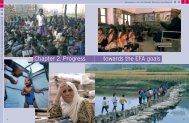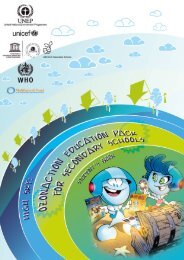Financing Education / pdf - Unesco
Financing Education / pdf - Unesco
Financing Education / pdf - Unesco
Create successful ePaper yourself
Turn your PDF publications into a flip-book with our unique Google optimized e-Paper software.
0<br />
2<br />
0<br />
8<br />
CHAPTER 4<br />
<strong>Education</strong> for All Global Monitoring Report<br />
The financial<br />
effort required<br />
to continue<br />
beyond primary<br />
education is<br />
often much<br />
larger than for<br />
the primary cycle<br />
Uganda and Zambia about one-third of households’<br />
discretionary spending was for education goods and<br />
services, the same share as in Bangladesh (Boyle<br />
et al., 2002). For poor households the burden can<br />
be particularly heavy. For instance, the household<br />
expenditure per primary school pupil in Tajikistan<br />
as a share of per capita household expenditure is<br />
twice as high for the poorest fifth of households as<br />
for the richest fifth.<br />
The financial effort required to continue beyond<br />
primary education is often much larger than for the<br />
primary cycle. Indian households surveyed in 2001<br />
in selected districts were spending twice the<br />
amount per child in upper primary government<br />
schools as in primary schools (Jha and Jhingran,<br />
2005). Fees paid by households in the Democratic<br />
Republic of Congo for each child enrolled in public<br />
primary schools represent up to 14% of average per<br />
capita income (varying by region), increasing up to<br />
42% in public secondary schools (World Bank,<br />
2005c). And in Mozambique, before the elimination<br />
of school fees, average total household expenditure<br />
per child enrolled in the upper grades of basic<br />
education was almost three times that for the lower<br />
grades, while expenditure on lower secondary could<br />
be nine times that for primary education (World<br />
Bank, 2005g). Again, the burden is heaviest for the<br />
poorest households. The share of a secondary<br />
student’s expenses in per capita household<br />
expenditure was roughly twice as high in the<br />
poorest households as in the richest in Guatemala,<br />
Nicaragua, Tajikistan and Timor-Leste (Table 4.7)<br />
School costs are a barrier<br />
to school access<br />
While some households can cover the expenses<br />
that are associated with school attendance, many<br />
poor households cannot. In addition, for such<br />
households the perceived benefits of schooling may<br />
not be sufficient to justify the expenditure. ‘Lack of<br />
money’, ‘economic problems’, ‘need to work’ and<br />
‘family can’t afford school expenses’ are the main<br />
reasons cited in several studies of why children do<br />
not attend school; see, for example, Bangladesh,<br />
Nepal, Uganda and Zambia (Boyle et al., 2002);<br />
Yemen (Guarcello et al., 2006b); and Albania,<br />
Kazakhstan, Latvia, Mongolia, Slovakia and<br />
Tajikistan (<strong>Education</strong> Support Program, 2007).<br />
In Uganda before the elimination of school fees,<br />
71% of children surveyed cited cost of attendance<br />
as the main reason for having dropped out of<br />
primary school (Deininger, 2003). Fees are cited<br />
as a major obstacle to school enrolment in China<br />
and Indonesia (Bentaouet-Kattan, 2006).<br />
Amplifying the effects of direct and indirect costs<br />
of schooling, many households tend to invest less<br />
in children for whom the value of schooling is<br />
perceived to be less important, or when cultural<br />
Table 4.7: <strong>Education</strong> expenditure as a share of household expenditure, selected countries<br />
<strong>Education</strong> expenditure as a share of total annual household expenditure<br />
All education levels Primary Lower secondary<br />
Guatemala (2000)<br />
Nicaragua (2001)<br />
Panama (2003)<br />
Tajikistan (2003)<br />
Timor-Leste (2001)<br />
Total<br />
Poorest<br />
20%<br />
Richest<br />
20%<br />
Total<br />
Poorest<br />
20%<br />
Richest<br />
20%<br />
Poorest<br />
20%<br />
5.1 2.2 8.2 2.5 1.8 3.9 7.6 5.8 7.6<br />
5.5 3.8 7.5 2.6 2.7 3.1 4.5 5.6 4.2<br />
7.7 5.5 9.3 4.0 2.8 6.6 5.2 4.4 6.9<br />
5.5 6.3 6.0 2.8 3.6 2.3 3.4 4.3 3.2<br />
1.5 1.5 1.5 1.0 1.1 0.6 1.5 2.5 1.2<br />
Total<br />
Richest<br />
20%<br />
<strong>Education</strong> expenditure per pupil as a share of annual household expenditure per capita<br />
All education levels Primary Lower secondary<br />
Guatemala (2000)<br />
Nicaragua (2001)<br />
Panama (2003)<br />
Tajikistan (2003)<br />
Timor-Leste (2001)<br />
Total<br />
Poorest<br />
20%<br />
Richest<br />
20%<br />
Total<br />
Poorest<br />
20%<br />
Richest<br />
20%<br />
Poorest<br />
20%<br />
13.5 8.4 18.5 9.3 7.3 14.0 31.1 47.7 26.5<br />
13.7 11.3 17.5 9.0 9.1 11.1 18.7 34.7 15.0<br />
18.9 15.6 20.4 15.2 11.5 24.1 22.9 28.2 25.5<br />
16.4 21.0 15.2 13.9 19.4 10.4 15.0 20.5 12.5<br />
4.2 4.6 3.7 3.3 3.8 2.1 7.7 14.2 5.4<br />
Total<br />
Richest<br />
20%<br />
Sources: Guatemala Government and World Bank (2000); Nicaragua National Statistics and Census Institute and World Bank (2001); Panama Government<br />
and World Bank (2003); Tajikistan Goscomstat and World Bank (2003); Timor-Leste National Statistics Directorate and World Bank (2001).<br />
152

















